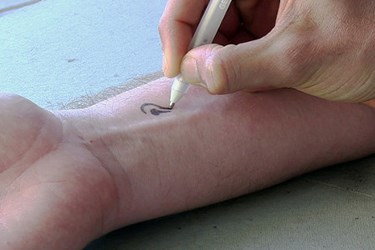Sensors You Can Draw: Measuring Glucose With Bio-Ink Tattoos Penned On The Skin

Scientists have filled ordinary ballpoint pens with a bio-ink that enables them to literally draw sensors on human skin to measure glucose levels. The research team says that the sensor technology shows potential for both clinical use by doctors and home use by patients.
The biocatalytic pens were designed at the University of California, San Diego’s (UCSD’s) Jacobs School of Engineering, by a team led by Joseph Wang. According to a university press release, the researchers wanted to develop a long-lasting, nontoxic ink that could adhere to surfaces and function as an electrode in a sensor.
Their design uses biocompatible polyethylene glycol, which is already used in some drug delivery systems, as a binder. Graphite powder provides conductivity, and chitosan helps the ink to stick to a surface. Xylitol, a sugar substitute, acts a stabilizing agent for the enzymes. The researchers are confident that the ink can hold up over time in various storage conditions.
The UCSD press release describes the development of tattoo-like glucose sensors using the technology: “In this study, they used pens, loaded with an ink that reacts to glucose, to draw reusable glucose-measuring sensors on a pattern printed on a transparent, flexible material which includes an electrode. Researchers then pricked a subject’s finger and put the blood sample on the sensor. The enzymatic ink reacted with glucose and the electrode recorded the measurement, which was transmitted to a glucose-measuring device. Researchers then wiped the pattern clean and drew on it again to take another measurement after the subject had eaten.”
According to the CDC, over 29 million Americans have diabetes. Another 86 million are in danger of developing the disease, 15 to 30 percent of whom will do so in the next five years.
Regular glucose testing required by diabetic patients uses a finger-stick test, which many patients find uncomfortable or cost prohibitive. Complications due to non-compliance can be extremely detrimental to the patient’s health management.
The development of easier and more convenient glucose sensors has been a primary focus of Wang’s research team for several years.
Earlier this year, his team introduced a temporary tattoo that could monitor glucose levels without finger pricks and eventually transmit the information collected directly to the patient’s doctor.
“Presently the tattoo sensor can easily survive for a day. These are extremely inexpensive — a few cents — and hence can be replaced without much financial burden on the patient,” graduate student Amay Bandodkar said in a UCSD press release.
Wang estimates that one of his new bio-ink pens could be used to draw the equivalent of 500 high-fidelity glucose sensor strips, the costliest component of at-home glucose sensor testing.
Medicine is not the only application for the bio-ink sensors. Wang imagines that the technology could also serve both environmental and military applications. “Our new biocatalytic pen technology holds considerable promise for a broad range of applications on site and in the field,” he said in the press release.
Image credit: University of California, San Diego
